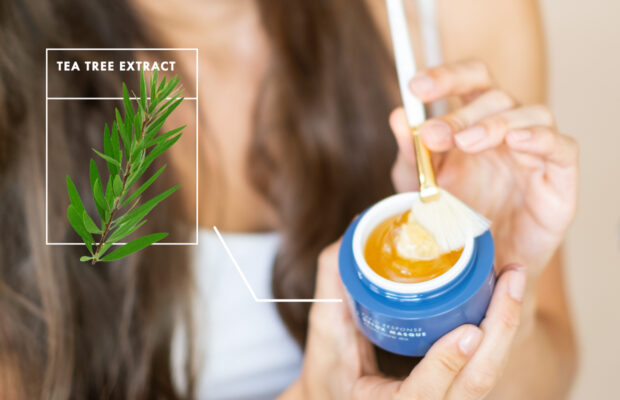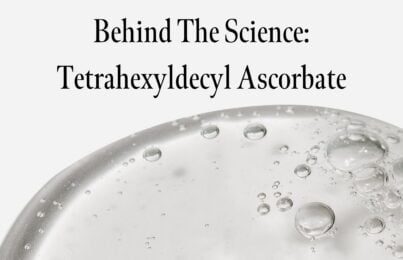As an esthetician with 35 years of experience with acne, I understand the challenge of finding the right products and ingredients to clear and prevent the appearance of breakouts. After all, from cysts to pustules and papules, breakouts are simply not equal. However, there is one ingredient that is my go-to because it truly works. I’ve seen clients experience incredible results, but I was curious to dive into the science behind the ingredient so I recently tested it in the lab– and I couldn’t believe what I saw! Read on to learn all about my favorite ingredient, Tea Tree Oil.
What Is Tea Tree Oil?
Originating in Australia, but now found in parts of India, New Zealand, and China, tea tree oil has an illustrious history in medicine and beauty. A result of steam-distilling tea tree leaves, this ingredient is known for its versatility across skincare. In fact, long before we learned how to extract tea tree oil, the aboriginal people of Australia used tea tree leaves to treat bruises, skin infections, wounds, and insect bites.
Much like other plant-based compounds, such as willow bark, chamomile extract, and witch hazel, there are a lot of studies backing tea tree oil as helpful for acne-prone skin. Derived from the Australian plant Melaleuca alternifolia, tea tree oil has three important features that make it beneficial for skin: it is anti-inflammatory, antibacterial, and it can work as a solvent to help break up buildups of dirt, oil, or debris clogging the pores.
How Tea Tree Oil Combats Acne
Antibacterial Properties
Tea tree essential oil is proven to be a powerful antibacterial, anti-fungal, antiviral, and anti-parasitic (this is why it’s such a powerful insect repellent!). These properties are predominantly due to Terpinen-4-ol. This compound is notably excellent at breaking down the protective barrier surrounding bacteria, attributing to their loss of membrane integrity and function and essentially breaking down bacteria’s defense mechanism.
How We Tested Tea Tree Oil’s Acne-Fighting Capabilities
With tea tree oil being the star ingredient in one of our best-selling products, Rapid Response Detox Masque, it only makes sense to officially test the efficacy of its blemish-fighting properties. So, what did this process look like? Buckle up, science nerds!
Testing begins by growing real acne bacteria (C. acnes), the kind that leads to breakouts, in a broth until there are enough bacteria present to conduct a study. Once this is attained, that broth is exposed to Rapid Response Detox Masque. An instant (or near instant) measurement is then taken, which we call t=0, that will determine how quickly the product goes to work. After 7 minutes, or t=7, the amount of bacteria remaining in the broth will be compared to t=0, determining the percentage of acne-causing bacteria controlled.
The efficacy of Rapid Response Detox Masque ultimately comes down to three measurements: the initial amount of bacteria, t=0, and t=7.
The Test Results
The initial amount of bacteria was 2.7 x 10^6. At t=0, we counted 2.6 x10^6, meaning there was a 3.7% reduction in bacteria almost immediately! This may not sound like a lot, but it’s unrealistic to expect total control of acne-causing bacteria immediately and this is a promising start.
After just 7 minutes, or t=7, the final measurement was taken to calculate the amount of acne-causing bacteria left in the petri dish. And the results are in… we counted 3.0 x 10^4, which is a 98.89% reduction. Yes, you read that right. A 98.89% reduction in acne-causing bacteria. Wow, even I was shocked!
The Takeaway
Okay, enough of the technical jargon. The bottom line is this: Rapid Response Detox Masque not only works instantly to control acne-causing bacteria, but it also clears skin by balancing any bad bacteria on the surface in just seven minutes. Formulated with both tea tree and manuka oils, this mask works as a total reset to balance skin and minimize the appearance of active breakouts.
Practical Guide to Using Tea Tree Oil for Acne
Using Tea Tree Oil Directly vs In Products
Now that you’ve seen the results when tea tree oil is used as an ingredient within a formula, let’s dive into what it looks like when using tea tree oil in its pure form.
When it comes to using essential oils, like tea tree oil, eucalyptus oil, lavender oil, etc., you should never apply them directly to skin. Since tea tree oil is an oil-soluble, aromatic fraction from a tea tree leaf, the terpenes within it are extremely strong compounds that can cause sensitization when not diluted. In fact, these oils are actually only efficacious at such a low level already that there would never be a need to put 100% solution on your skin. Tea tree oil will always be better within a product with several other ingredients since essential oils have dermal limits. Remember, more does not always mean better!
If you already have pure tea tree oil on hand and you don’t want it to go to waste, you can always dilute it with a carrier oil, such as jojoba, rosehip, or coconut oil. This will act as a hydrating counter-force to any of its drying effects. I recommend using 99 grams of carrier oil for every 1 gram of tea tree oil.
Application Tips
If it’s your first time experimenting with tea tree oil, it’s essential to perform an at-home patch test to ensure it’s a compatible essential oil for your skin. While generally a harmless ingredient, everybody’s skin is different, so It’s better to be safe than sorry!
If you start to experience any redness, sensitivity, or irritation, it’s important to discontinue use.
For some skin types, such as those with an imbalance of acne-causing bacteria that lead to breakouts, this may be a good option for preventative care. However, I generally advise against putting tea tree oil on anything other than active breakouts, as ingredients like salicylic acid and benzoyl peroxide are usually better at prevention. This is why I generally promote salicylic acid products, like BHA Clarifying Serum, for breakout prevention and Rapid Response Detox Masque for more immediate, active breakouts. However, any of these ingredients would be a better option than using nothing at all.
How Long Does Tea Tree Oil Take to Work?
While tea tree oil generally goes to work right away, the speed in which you see results will almost always depend on which stage of a blemish’s life cycle you are in. For example, if you are dealing with a lot of active breakouts, then you are already in the midst of a cycle and experiencing congested pores and inflammation. This means that even if you use a tea tree oil product, it still takes time for your skin to turnover and for the inflammation to subside.
Unfortunately, this means you won’t be experiencing any miraculous overnight transformations (dang!), but it does mean that you have instantly moderated acne-causing bacteria on the skin, taking you one step closer to clearer, healthier skin.
Precautions and Side Effects of Using Tea Tree Oil
Believe it or not, many people are buying tea tree oil that isn’t really tea tree oil. Tea tree oil has a unique chemical composition that is primarily composed of terpenes, a compound very specific to this essential oil. There are a few terpenes that are critical for tea tree oil, not only giving it its characteristic medicinal odor but also helping carry out the benefits that tea tree oil can provide in skincare. It’s critical to know where the tea tree oil in your products is sourced from to reap the full benefit of the ingredient.
Hint: Real tea tree oil will have a high Terpinen-4-ol content and low cineol content–or, look for tea tree oil guaranteed to be real Australian tea tree oil!
Tea Tree Oil Alternatives for Skin Health
Maybe you experience allergic reactions or maybe you simply choose to steer clear of tea tree oil, either way, this ingredient may not be everyone’s perfect match. Unfortunately, there are not a lot of great tea tree dupes due to its very specific chemical profile. However, these are a few ingredients that I think can help achieve similar results.
Manuka Oil
From the genus Leptospermum scoparium, manuka Oil also originates from a type of tea tree species. With impressive antimicrobial properties, a high level of terpenes, and a scent that’s often compared to, if not preferred over, traditional tea tree oil, this makes for a worthy alternative.
Fact: Rapid Response Detox Masque also has manuka oil in it, making its formula effective against multiple types of bacteria!
Eucalyptus Oil
Eucalyptus oil has a very similar profile to tea tree oil but contains different ratios of terpenes. Similarly, it also has antibacterial and anti-inflammatory components, making it a good option for acne-prone skin with an imbalance of oil production.
So, Does Tea Tree Oil Help with Acne?
Yes, it sure does. As an acne specialist, I know this ingredient is safe enough to use twice daily if desired but is generally best when used during active breakouts. The study we conducted with a specific product, the Rapid Response Detox Masque, highlights its potential to control acne-causing bacteria in just 7 minutes. When used correctly, tea tree oil can be a valuable addition to your skincare routine. I really urge you to try it to see if you can achieve healthier, clearer-looking skin. I know this post was a lot of information but I truly hope you found it helpful.
Celebrity Esthetician & Skincare Expert
As an esthetician trained in cosmetic chemistry, Renée Rouleau has spent 35 years researching skin, educating her audience, and building an award-winning line of products. Her hands-on experience as an esthetician and trusted skin care expert has created a real-world solution — products that are formulated for nine different types of skin so your face will get exactly what it needs to look and feel its best. Trusted by celebrities, editors, bloggers, and skincare obsessives around the globe, her vast real-world knowledge and constant research are why Marie Claire calls her “the most passionate skin practitioner we know.”



